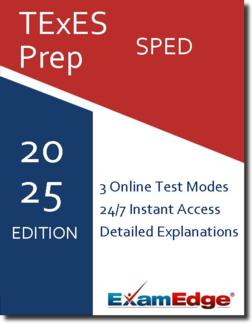TExES Special Education (161) Practice Tests & Test Prep by Exam Edge - Topics
Based on 22 Reviews
- Real Exam Simulation: Timed questions and matching content build comfort for your TExES SPED Specialist test day.
- Instant, 24/7 Access: Web-based TExES Special Education Specialist EC–12 practice exams with no software needed.
- Clear Explanations: Step-by-step answers and explanations for your TExES exam to strengthen understanding.
- Boosted Confidence: Reduces anxiety and improves test-taking skills to ace your TExES Special Education Specialist EC–12 (186).

Understanding the exact breakdown of the TExES Special Education Specialist EC–12 test will help you know what to expect and how to most effectively prepare. The TExES Special Education Specialist EC–12 has 90 multiple-choice questions and 1 essay questions. The exam will be broken down into the sections below:
| TExES Special Education Specialist EC–12 Exam Blueprint | ||
|---|---|---|
| Domain Name | % | Number of Questions |
| Legal and Ethical Guidelines and Knowledge of Learners | 18% | 16 |
| Assessment and Program Planning | 18% | 16 |
| Curricular Knowledge and Instructional Practices | 27% | 24 |
| Professional Collaboration, Learning, and Responsibilities | 18% | 16 |
| Analysis and Response | 20% | 18 |


